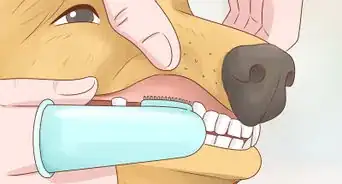This article was co-authored by Deanne Pawlisch, CVT, MA. Deanne Pawlisch is a Certified Veterinary Technician, who does corporate training for veterinary practices and has taught at the NAVTA-approved Veterinary Assistant Program at the Harper College in Illinois and in 2011 was elected to the board of the Veterinary Emergency and Critical Care Foundation. Deanne has been a Board Member of the Veterinary Emergency and Critical Care Foundation in San Antonio, Texas since 2011. She holds a BS in Anthropology from Loyola University and an MA in Anthropology from Northern Illinois University.
This article has been viewed 32,569 times.
Water puppies suffer from the abnormal accumulation of body fluids, also called edema. The condition is known as anasarca. This condition occurs when extra fluid is held in the space between the cells of the body and results in a generalized swelling of the body. If a puppy is born with this condition you will need to identify the problem and give treatment very quickly to give the puppy a chance of survival. However, survival rates for this condition are very low, so you should focus some of your energy on making the puppy as comfortable and pain free as possible.[1]
Steps
Identifying Edema
-
1Identify any risk factors the mother dog may have. While it is not known exactly what causes anasarca, some dog breeds are more likely to get the condition. Your puppy has more of a chance to develop anasarca it is a brachycephalic breed. This type of dog has a short, compressed snout and wide skull, and includes bulldogs, Boston terrier, and pugs for example.[2]
- If you have a brachycephalic dog that you are breeding, you should make sure the dog is getting proper prenatal care. However, because the condition is not totally understood, even with proper care the puppies may be born with anasarca.
-
2Have an ultrasound done on your pregnant dog. In order to assess whether a pregnancy is going well, your veterinarian may want to do an ultrasound. With an ultrasound your veterinarian may be able to assess whether any of the puppies have anasarca.[3]
- Even with a clear ultrasound, one or some of the puppies may be born with anasarca. This condition can develop at any point in the pregnancy but often occurs very late in the pregnancy.
Advertisement -
3Look for symptoms of anasarca on a newborn puppy. If one or more of the puppies have anasarca is will be clear after birth. The puppies will be physically swollen, sometimes being two to four times bigger than other puppies in the litter without the condition.[4]
- Puppies with anasarca can become so big that they get stuck in the birth canal. These puppies will need to be born via cesarean section.[5]
Helping a Puppy With Edema
-
1Give immediate care. Make sure to hold the puppy’s head up and extend its neck, so that its airway is as clear as possible.[6] Also keep the puppy warm and try to stimulate urination by running your finger across its genitalia every couple of minutes. However, you only need to stimulate the puppy if it is eating and not with the mother. Keep the puppy warm and continue rubbing it to help it breathe and move.
- This should be continued until the puppy is under veterinary supervision.
-
2Take the puppy to a veterinarian immediately. For a puppy with anasarca to have a chance of survival, it needs to be treated by a veterinarian. If your dog gave birth at home, then you need to take the puppy to a veterinary office right away.
- If your normal veterinary office is closed when the mother dog gives birth, then you should take the affected puppy to the closest 24 veterinary emergency clinic.
-
3Allow the veterinarian to treat the fluid retention. As soon as a puppy is born with anasarca it should begin treatment to stand any chance of survival. Treatment usually includes giving the puppy a diuretic to reduce the amount of fluid the puppy is retaining.[7]
- The bodies of puppies with anasarca are also gently massaged to promote circulation.
- If the condition is mild, the puppies can go on to live normal lives.
- Even with prompt treatment, however, a puppy with a severe case of anasarca has a very slim chance of survival.
-
4Give the puppy palliative care. If the puppy has a severe case of anasarca, it has a very low chance of survive. If this is the case with your puppy, then you should focus on making sure it is comfortable and pain free instead of focusing on recovery.[8]
- Consult with your veterinarian about the health of the puppy and whether it has any chance of recovery. If it doesn't, then your veterinarian will have some suggestions about how to stop the puppies' suffering. This could include keeping it warm and giving it medication to alleviate any pain. In some cases, this could mean compassionate euthanasia.
- Prepare yourself that the outcome may be death. In many cases of anasarca, the puppy is still born or dies quickly after birth.
Warnings
- Be aware that this is a hereditary condition and euthanasia may be the best option to prevent the puppy from suffering.⧼thumbs_response⧽
References
- ↑ https://www.purinaproclub.com/resource-library/pro-club-updates/researchers-aim-to-find-genetic-marker-for-anasarca/
- ↑ http://www.theveterinaryexpert.com/nose-and-throat/brachycephalic-dog/
- ↑ https://www.purinaproclub.com/resource-library/pro-club-updates/researchers-aim-to-find-genetic-marker-for-anasarca/
- ↑ http://bulldogguide.com/what-are-bulldog-water-puppies/
- ↑ https://www.purinaproclub.com/resource-library/pro-club-updates/researchers-aim-to-find-genetic-marker-for-anasarca/
- ↑ https://www.dogbreedinfo.com/whelpingwaterpuppies.htm
- ↑ https://www.purinaproclub.com/resource-library/pro-club-updates/researchers-aim-to-find-genetic-marker-for-anasarca/
- ↑ https://www.dogbreedinfo.com/whelpingwaterpuppies.htm
About This Article
If your newborn puppy has edema, keep it warm and take it to a veterinarian immediately, since the vet will have to reduce the fluids in its body in order for it to survive. On the way to the vet, you can care for your puppy by holding its head up and extending its neck to make its airway as clear as possible. While in this position, try to get it to urinate by running your finger across its genitalia every couple of minutes, since urination will help it remove fluid from its body. However, you only need to do this if it is eating and not with its mother. While doing this, rub your puppy’s body to help it breathe and move until you get to the vet. For more help from our Veterinary co-author, like how to identify risk factors for edema, read on.
-Step-1.webp)
-Step-2.webp)
-Step-3.webp)
-Step-4.webp)
-Step-5.webp)
-Step-6.webp)
-Step-7.webp)
























































